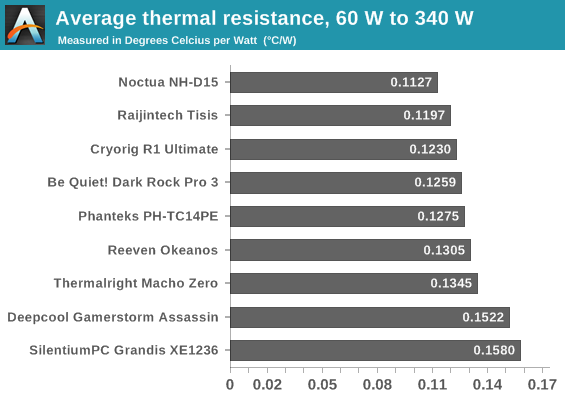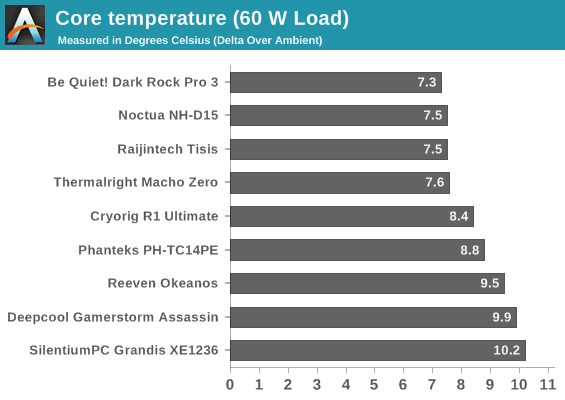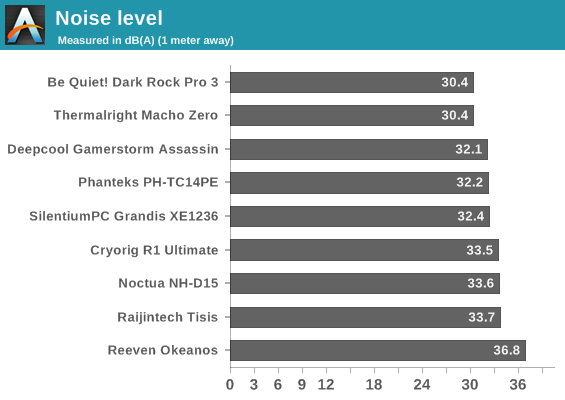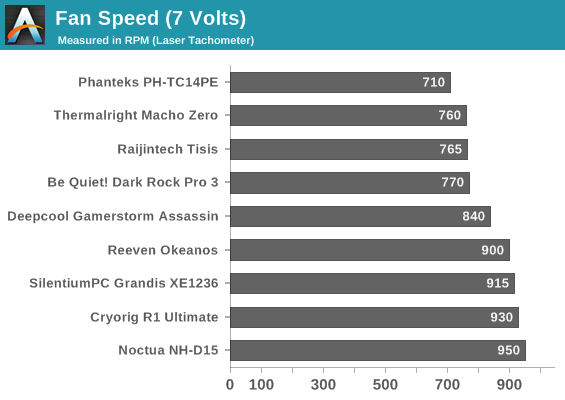Top Tier CPU Air Coolers Q3 2015: 9-Way Roundup Review
by E. Fylladitakis on July 6, 2015 8:00 AM ESTTesting results, low fan speed (7 Volts)


| Core Temperature, Constant Thermal Load |
|
|


*Note: When the cooler has two different fans, the fan speed of the faster fan is recorded.
**Note: Some of this review's PWM fans will not start if simply powered from a 7 Volts power source. Electronic supervision is required to start the fan and then reduce the voltage down to 7 Volts, or a PWM source.
Reducing the fan voltage down to 7 Volts shifts the thermal performance charts a little but brings all of the coolers down to virtually inaudible levels. The sole exception is the Okeanos, which definitely improved vastly in comparison to having its fans running at maximum speed, but remains audible.
With the Okeanos losing its advantage of brute force, the Noctua NH-D15 and the Raijintek Tisis now lead the thermal performance charts, closely followed by Cryorig's R1 Ultimate. The Phanteks PH-TC14PE is a bit more complicated, displaying that it can do much better at lower loads than with high loads, hinting that the airflow of the fans is simply not enough for this design to cope with very high loads. Be Quiet!'s Dark Rock Pro 3 is now showing thermal performance comparable to that of the aforementioned coolers, especially when the thermal load is low. Still, the Dark Rock Pro 3 technically loses its acoustics performance advantage. It may be dead-silent, with our equipment unable to record anything about the room's noise floor level, but the rest of the coolers are virtually inaudible as well.
The Thermalright Macho Zero is at advantage in these tests, as the cooler is optimized for low airflow situations. With the TY147A at a dead-quiet operating level, the Macho Zero offers very good thermal performance, especially at lower loads.
The two coolers with the worst overall thermal performance at this test were the Deepcool Assassin and the SilentiumPC Grandis. As far as the Grandis is concerned, the company will definitely not worry about their product not being able to compete directly with the best air coolers available, as it can still offer very good performance for the price of the cooler. The Assassin on the other hand fails to compete as well as it should, falling behind all other similarly sized products and even behind the Grandis during most of these tests.










135 Comments
View All Comments
mrvco - Monday, July 6, 2015 - link
I agree. It would be helpful to know how the 212 compares both with regards to cooling and quietness. I typically prefer "quieter" so I'd be curious to know how much better the "Dark Rock Pro 3" is than the 212... is it $40+ better?Eidigean - Monday, July 6, 2015 - link
I actually bought the 212 and added a second fan to it, not because it was cheap, but because it would fit between the 2x2 banks of memory on my Rampage IV Formula perfectly (with 1 mm of space on either side) allowing the tall memory heatsinks to rise up, and inconsequentially get a breeze from the fans. The CPU runs nice and cool (and quiet) with a modest overclock.I'd get the offset Noctua NH-D15S if I ever upgrade from a 4 core 3820 to a 6 core 4930K.
effortless - Monday, July 6, 2015 - link
Exactly my thoughts. The Cooler Master Hyper 212 EVO needs to be included in this test, to show exactly what 90% who buys CPU coolers are missing out on, or eventually not missing out on.randomlinh - Monday, July 6, 2015 - link
I'm confused about your complaint. What's wrong w/ the 212? What's wrong w/ saving $10 for 1 deg celcius difference?I genuinely don't know, I have a 212 from almost 4 yrs ago? It works. It's quiet (for the time). The only complaint is if I try to go super small form factor, it won't work.
icrf - Monday, July 6, 2015 - link
If it were only $10 I might agree with you, but when it's half the price, and sometimes a whole lot less, it makes a lot of sense. I looked at the Noctua when I built my 5820 last fall, and couldn't justify the 2.5x price. For $35, the 212 EVO is a great cooler. As good as the Noctua is, it's not two and a half times as good. That's why the 212 is so popular. It's in the proverbial sweet spot.andrewaggb - Monday, July 6, 2015 - link
I agree. I've bought several 212 EVO's and I've been very happy with them. I was mostly looking for something that would run quiet under load (without overclocking) and I think they've been great. I've used some less expensive coolers and they were much worse - so in my opinion it's the cheapest cooler that met my needs.Araemo - Monday, July 6, 2015 - link
Obsession is pretty harsh given the facts... I went and looked up a comparison over on frostytech, and it looks like the Hyper 212 evo is only 2C hotter than the Noctua chosen as the realistic 'best choice'.. for 1/3 the price. Given that my ambient temps change by more than that 2C over the course of a year, 2C is never the stability margin I use on my overclocks.Nfarce - Monday, July 6, 2015 - link
Except that the 212 is not a "premium" cooler. When you start getting into extreme overclocks like I have (i5 4690k @4.8GHz, or a 23% overclock) and into water cooling needs territory, the 212 falls well more than a 2C behind which is where it is on lower level overclocks (5-15%) on my chip.StrangerGuy - Monday, July 6, 2015 - link
Who cares whether if the 212 isn't a "premium" cooler when I can simply buy the 4790K at stock 4.4GHz instead of premium cooling to barely OC a 4690K past a 4790K. You overclockers STILL think there is tremendous value to be had with OCing when the 2500K ship have long sailed.Nfarce - Wednesday, July 8, 2015 - link
According to my benchmark tests in games and applications like Sony Vegas Studio, my overclock to 4.8GHz yields quite a bit of performance increase over the stock turbo of 3.9GHz. Oh and since I was on a budget and game about 80% of the time on that 4690K rig, I justified saving the extra $100 over a 4790K and put it towards a better GPU solution.And yes, I still have a 2500K build as well (not sure what that has to do with the price of ketchup), which used to be overclocked to 4.6GHz on that NH-D14 cooler (it is now relegated to backup duties and running at stock speeds on a Zalman 9700LED cooler). Which, incidentally, roughly equals the performance of my Devil's Canyon chip running at 4.2GHz.